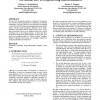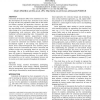93
Voted
ACMDIS
2000
ACM
15 years 5 months ago
2000
ACM
In this paper we propose a 3-step method for designing emotionally rich interactions, illustrated by the design of an alarm clock. By emotionally rich interaction we understand in...
80
Voted
ACMDIS
2000
ACM
15 years 5 months ago
2000
ACM
We may view documents, not only as “containers” for information, but also as active participants in organizing and sustaining communities. This paper discusses our experiences...
111
click to vote
ACMDIS
2000
ACM
15 years 5 months ago
2000
ACM
Contextual development differs from traditional user interface development in several ways: It focuses on the context of usage and the user population rather than on the technical...
100
click to vote
ACMDIS
2000
ACM
15 years 5 months ago
2000
ACM
This paper describes the experience gained in the case study of adapting the Bridge, a GUI design method to the design of non-GUI interactive consumer products. An industrial desi...
118
click to vote
ACMDIS
2000
ACM
15 years 5 months ago
2000
ACM
: Expanding the functionality of a successful system is always a challenge; the initial simplicity and ease-of-use is easily lost in the process. Experience indicates that this pro...
110
click to vote
ACMDIS
2000
ACM
15 years 5 months ago
2000
ACM
The successful creation of telepresence and virtual environments requires a change in design paradigm. We must move away from attempts to recreate reality in its entirety toward t...
ACMDIS
2000
ACM
15 years 5 months ago
2000
ACM
This paper presents an approach to designing interactive systems that enables critical performance parameters to be identified and models of performance to be constructed. The met...
ACMDIS
2000
ACM
15 years 5 months ago
2000
ACM
Through a study of web site design practice, we observed that web site designers employ multiple representations of web sites as they progress through the design process, and that...
ACMDIS
2000
ACM
15 years 5 months ago
2000
ACM
Field research methods are useful in the many aspects of HumanComputer Interaction research, including gathering user requirements, understanding and developing user models, and n...
ACMDIS
2000
ACM
15 years 5 months ago
2000
ACM
In this paper we describe techniques used to move from a wide variety of speculative concepts to three working prototypes of potentially commercial audiophotography products. Stag...


